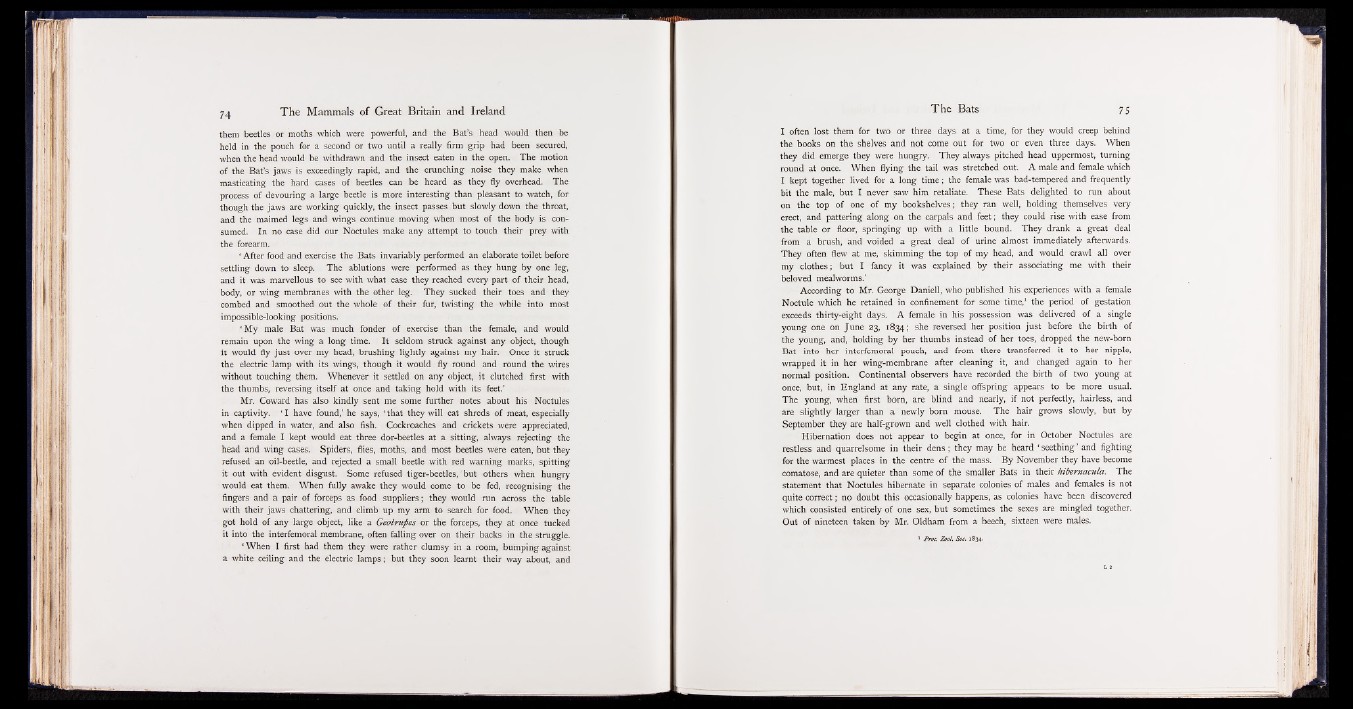
them beetles or moths which were powerful, and the Bat’s head would then be
held in the pouch for a second or two until a really firm grip had been secured,
when the head would be withdrawn and the insect eaten in the open. The motion
of the Bat’s jaws is exceedingly rapid, and the crunching noise they make when
masticating the hard cases of beetles can be heard as they fly overhead. The
process of devouring a large beetle is more interesting than pleasant to watch, for
though the jaws are working quickly, the insect passes but slowly down the throat,
and the maimed legs and wings continue moving when most of the body is consumed.
In no case did our Noctules make any attempt to touch their prey with
the forearm.
‘ After food and exercise the Bats invariably performed an elaborate toilet before
settling down to sleep. The ablutions were performed as they hung by one leg,
and it was marvellous to see with what ease they reached every part of their head,
body, or wing membranes with the other leg. They sucked their toes and they
combed and smoothed out the whole of their fur, twisting the while into most
impossible-looking positions.
‘ My male Bat was much fonder of exercise than the female, and would
remain upon the wing a long time. It seldom struck against any object, though
it would fly just over my head, brushing lightly against my hair. Once it struck
the electric lamp with its wings, though it would fly round and round the wires
without touching them. Whenever it settled on any object, it clutched first with
the thumbs, reversing itself at once and taking hold with its feet.’
Mr. Coward has also kindly sent me some further notes about his Noctules
in captivity. ‘ I have found,’ he says, ‘ that they will eat shreds of meat, especially
when dipped in water, and also fish. Cockroaches and crickets were appreciated,
and a female I kept would eat three dor-beetles at a sitting, always rejecting the
head and wing cases. Spiders, flies, moths, and most beetles were eaten, but they
refused an oil-beetle, and rejected a small beetle with red warning marks, spitting
it out with evident disgust. Some refused tiger-beetles, but others when hungry
would eat them. When fully awake they would come to be fed, recognising the
fingers and a pair of forceps as food suppliers; they would run across the table
with their jaws chattering, and climb up my arm to search for food. When they
got hold of any large object, like a Geotrufles or the forceps, they at once tucked
it into the interfemoral membrane, often falling over on their backs in the struggle.
‘ When I first had them they were rather clumsy in a room, bumping against
a white ceiling and the electric lamps; but they soon learnt their way about, and
I often lost them for two or three days at a time, for they would creep behind
the books on the shelves and not come out for two or even three days. When
they did emerge they were hungry. They always pitched head uppermost, turning
round at once. When flying the tail was stretched out. A male and female which
I kept together lived for a long time; the female was bad-tempered and frequently
bit the male, but I never saw him retaliate. These Bats delighted to run about
on the top of one of my bookshelves; they ran well, holding themselves very
erect, and pattering along on the carpals and feet; they could rise with ease from
the table or floor, springing up with a little bound. They drank a great deal
from a brush, and voided a great deal of urine almost immediately afterwards.
They often flew at me, skimming the top of my head, and would crawl all over
my clothes; but I fancy it was explained by their associating me with their
beloved mealworms.’
According to Mr. George Daniell, who published his experiences with a female
Noctule which he retained in confinement for some time,1 the period of gestation
exceeds thirty-eight days. A female in his possession was delivered of a single
young one on June 23, 1834; she reversed her position just before the birth of
the young, and, holding by her thumbs instead of her toes, dropped the new-born
Bat into her interfemoral pouch, and from there transferred it to her nipple,
wrapped it in her wing-membrane after cleaning it, and changed again to her
normal position. Continental observers have recorded the birth of two young at
once, but, in England at any rate, a single offspring appears to be more usual.
The young, when first born, are blind and nearly, if not perfectly, hairless, and
are slightly larger than a newly born mouse. The hair grows slowly, but by
September they are half-grown and well clothed with hair.
Hibernation does not appear to begin at once, for in October Noctules are
restless and quarrelsome in their dens; they may be heard ‘ seething ’ and fighting
for the warmest places in the centre o f the mass. By November they have become
comatose, and are quieter than some of the smaller Bats in their kibemacula. The
statement that Noctules hibernate in separate colonies of males and females is not
quite correct; no doubt this occasionally happens, as colonies have been discovered
which consisted entirely of one sex, but sometimes the sexes are mingled together.
Out of nineteen taken by Mr. Oldham from a beech, sixteen were males.
1 Proc. Zool. Soc. 1834.